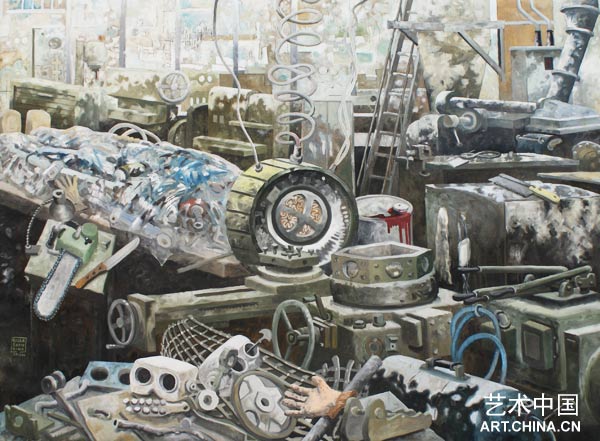|

此次,東京畫廊+BTAP舉辦大巖·奧斯卡爾個展《亞洲廚房》。此次,大巖的中國大陸首次展覽,不僅要展示藝術家親自造訪中國,現地取材,創作的無論從尺寸還是內容上都宏偉壯大的5張大型油畫新作,還將展示藝術家以往的畫作、版畫作品。
大巖.奧斯卡爾1965年出生於巴西聖保羅係第2代日裔巴西人。幼年時代漫畫的耳濡目染,使大巖逐漸從中學、高中開始創作作品,進而在大學時代就出展多個展覽會,在巴西開始了其現代藝術家的歷程。1989年于聖保羅大學建築學部畢業後,為了尋求更加廣闊的創作空間,大巖輾轉與東京(1991~2001年)、紐約(2002年~)之間。直面每個城市的環境與歷史,通過藝術家自身在每個城市中的生活經歷,將自己的親身感受與獨創的幽默交織在一起融入作品。
2008年7月,大巖訪問了奧運會即將揭幕的北京,在這次首次訪華的經歷中,大巖分別造訪了BTAP的所在地北京798藝術區和城市繁華區,目睹了急速發展的中國,感慨萬分:“亞洲時代必定以中國為中心開始”。大巖將在北京逗留期間發現的各種各樣的互無關聯的繪畫元素,自由自在的進行組合,創作的作品展現了具有獨特且豐富的想像力和深厚故事性的亞洲世界。繁華區一隅,廢棄物遍地的幽暗土地;鋼水如瀑布一般飛瀉的工廠內部之風景等等。大巖從多方面捕捉亞洲之實態,用超越現實的氛圍和魄力十足的畫風,描繪出亞洲的萬種風情。雖然作品內容以亞洲為中心,但是這些作品的題材歸根結底還是圍繞著大城市的均一化、能源問題、産業國際化、經濟問題等等不只局限于亞洲的全球性問題。稱自己為"地球人"的大巖冷靜地與國際性社會的整體問題對峙,並且將其與自身的世界觀融和在一起。
大巖在其作品中沒有描繪人物,他事先考慮到觀賞者之存在,進而創作作品。那種深入畫境的感覺,對於觀賞者來説無疑是一種深奧的妙趣。此次展覽會展出的作品中有橫幅5.5M的超大作品。在這些壓倒性比例的作品面前,初次面對大巖作品的中國人之間會誕生何種話題呢?
在致本展覽的文章中,大巖詮釋到 :
"看到我的作品,人們會猜到我是哪國人嗎?雖然成長的環境以及後來居住的場所對於世界觀和人生觀有所影響;但是我認為單純出現在作品中的內容是無國籍的。也就是説,我只是一個單純的地球人。此次展覽,大多是以亞洲為焦點的作品,但是大城市的國際化、能源問題、衰敗的經濟、跨國界産業等等也是世界共同之課題。⋯⋯即使近代文明發源於西洋社會,但是現在地球上的超高層大廈的2/3建於亞洲。我認為亞洲時代必定以中國為中心開始。我想把這篇文章送給散策于798藝術區的年輕人。希望他們放眼世界,理解其他人的存在以及他們的文化,度過有意義的一生。我能夠在北京展覽,很高興的感覺到地球是一個大家庭。"
大巖.奧斯卡爾(紐約.2009年1月29日)
值此,誠邀您蒞臨觀賞以急速發展的亞洲為出發點,用獨創的視角描繪出我們周邊之社會的《Asian Kitchen》展。5月16日下午15:00時舉行展覽開幕式,屆時本展覽的畫冊也將同步發行。
'if you direct your eyes more to the outer world and understand there are so many and various peoples and cultures on the earth, you can lead a very interesting life.'
Oscar Oiwa
New York, January 29th, 2009
Tokyo Gallery + BTAP presents a solo exhibition by Oscar Oiwa entitled "Asian Kitchen." This is Oiwa's first exhibition in China, centering on 5 massive new oil paintings whose size and narrative are both based on the artist’s firsthand experience of China, as well as older prints and other works.
Oiwa is a second-generation Japanese Brazilian born in 1965 in Sao Paolo, Brazil. He became familiar with manga comics from an early age, and slowly began making work during his junior high and high school days. While still enrolled at university, he started exhibiting his work at several exhibitions, launching his career as a contemporary artist in Brazil. After graduating from the department of architecture at the University of Sao Paolo in 1989, and seeking to widen the scope of his practice as an artist, Oiwa shifted his base first to Tokyo (1991-2001), and then to New York (2002-). By drawing on his own life experiences in each city and confronting its urban environment and history, Oiwa interweaves a sense of humor entirely his own with his understanding of the world in his work.
In July 2008, Oiwa visited Beijing, a city just then on the verge of a wave of pre-Olympic excitement. During his stay, while walking through Beijing's Dashanzi Art District and other parts of the city, Oiwa experienced firsthand the sense of dynamism brought about by rapid development, leaving him with no doubt that "the new Asian era will have China as its center."
Oiwa's new works made after returning home consist of a free combination of diverse, apparently disconnected elements that attracted his interest during his stay in China. The result is a vision of Asia imbued with a unique imaginative power and sense of narrative. In these scenes of bustling downtown areas, depressing tracts of land buried in waste, and the insides of factories where waterfalls of molten iron flow through and spill over, Oiwa captures the diverse realities of Asia, depicting its many faces with a forceful style and somewhat fantastical atmosphere that appears to transcend reality.
Although Oiwa's paintings depict Asia, their underlying themes are global ones that are not limited to this region alone: the homogenization of large cities, energy crises, the globalization of industry and economic problems. Oiwa, who calls himself an "earthling," confronts the problems of the global community as a whole with calm self-possession and conflates them with his own personal view of the world.
Another characteristic feature of Oiwa's paintings is the absence of people. Oiwa paints while taking his audience into consideration in advance, and viewers of his work revel particularly in the feeling of being drawn into the painting. Among the works on display at this exhibition are large scale paintings measuring 5.5 meters wide. One can only wonder what sort of dialogue might emerge between Chinese people seeing Oiwa's work for the first time, standing in front of these paintings with their massive, overwhelming sense of scale.
The following is an excerpt from an essay written by Oiwa for this exhibition:
'I wonder, just like my accent, can my work give clues to people to see where I have come from ? I am sure that deep in my head and mind, there are many influences from how I was raised and where I lived afterwards, but things appearing in my paintings simply have no nationality - I take myself just as an earthling. Although many of the exhibited works in this show may seem to focus on Asia, on issues such as big cities under internationalization, energy problems, increasingly depressed economies, transnational industries, and so on. I think these are not only Asian but also global concerns. [abbr] Industrial revolution began in the West, but today, two-thirds of super high-rise buildings are actually in Asia. In my opinion, it is quite certain that the time of Asia will start with China as its center. Looking in from the outside, information from other countries seems to be secretly under governmental control in China. I would like to send a message to the young people who are strolling through 798 Art Zone, in which BTAP is located, and who are reading this text right now, that if you direct your eyes more to the outer world and understand there are so many and various peoples and cultures on the earth, you can lead a very interesting life. I am very happy to have this exhibition in Beijing, which enables me to feel the earth as a single country.'
Oscar Oiwa
New York, January 29th, 2009
We hope you take this opportunity to view "Asian Kitchen," an exhibition that addresses the society at large that surrounds us by taking Asia and its rapid growth as its point of departure. In addition, an opening reception in the presence of the artist will be held on May 16th (Sat) starting at 15:00. A catalog of works on display will also be published to coincide with the exhibition.
|

